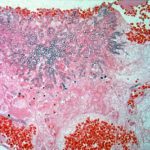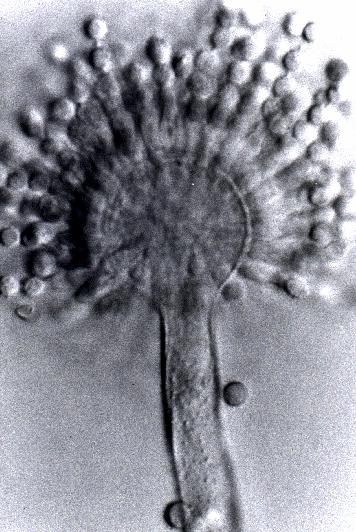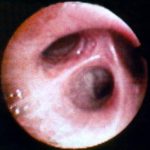Date: 26 November 2013
Aspergillus flavus
Copyright:
© Fungal Research Trust
Notes:
Colonies on CYA 60-70 mm diam, plane, sparse to moderately dense, velutinous in marginal areas at least, often floccose centrally, sometimes deeply so; mycelium only conspicuous in floccose areas, white; conidial heads usually borne uniformly over the whole colony, but sparse or absent in areas of floccose growth or sclerotial production, characteristically Greyish Green to Olive Yellow (1-2B-E5-7), but sometimes pure Yellow (2-3A7-8), becoming greenish in age; sclerotia produced by about 50% of isolates, at first white, becoming deep reddish brown, density varying from inconspicuous to dominating colony appearance and almost entirely suppressing conidial production; exudate sometimes produced, clear, or reddish brown near sclerotia; reverse uncoloured or brown to reddish brown beneath sclerotia. Colonies on MEA 50-70 mm diam, similar to those on CYA although usually less dense. Colonies on G25N 25-40 mm diam, similar to those on CYA or more deeply floccose and with little conidial production, reverse pale to orange or salmon. No growth at 5°C. At 37°C, colonies usually 55-65 mm diam, similar to those on CYA at 25°C, but more velutinous, with olive conidia, and sometimes with more abundant sclerotia.
Sclerotia produced by some isolates, at first white, rapidly becoming hard and reddish brown to black, spherical, usually 400- 800 µm diam. Teleomorph not known. Conidiophores borne from subsurface or surface hyphae, stipes 400 µm to 1 mm or more long, colourless or pale brown, rough walled; vesicles spherical, 20-45 µm diam, fertile over three quarters of the surface, typically bearing both metulae and phialides, but in some isolates a proportion or even a majority of heads with phialides alone; metulae and phialides of similar size, 7-10 µm long; conidia spherical to subspheroidal, usually 3.5-5.0 µm diam, with relatively thin walls, finely roughened or, rarely, smooth.
Distinctive features
Aspergillus flavus is distinguished by rapid growth at both 25°C and 37°C, and a bright yellow green (or less commonly yellow) conidial colour. A. flavus produces conidia which are rather variable in shape and size, have relatively thin walls, and range from smooth to moderately rough, the majority being finely rough.
Images library
-
Title
Legend
-
Further details
Image G. Patient was a 9 year old girl 5 months post matched unrelated donor (MUD) bone marrow transplantation with T-cell depletion, with reduced respiratory function (dyspnoea), cough and crackles at the bases, without fever. Donor and recipient were CMV antibody negative. 5/10/98.
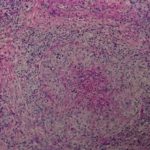 ,
,  ,
,  ,
, 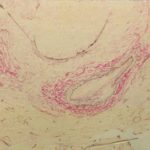 ,
, 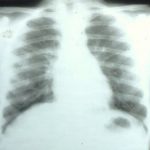 ,
,  ,
, 
-
Fluorescence microscopy was performed on the same sample as blankophor® staining according to Ruchel R. & Margraf S. 1993, Mycoses 36, 239-242. The artefactual staining of fibres and cellular elements is due to previous drying of the smear and recedes with time.
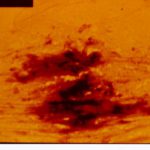
-
A needle biopsy of a solitary round infiltrate found near the thoracic wall in a patient with acute lymphoblastic leukaemia was gram-stained and then treated with an alkaline solution of the whitening agent Blankophor®.
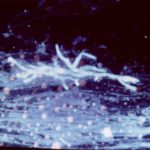
-
Medium power view (H&E) of cerebral abscess in which there are hyphae consistent with Aspergillus. Aspergillus fumigatus was grown from adjacent tissue.
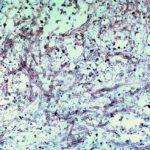
-
Medium power view (GMS) of kidney invaded by Aspergillus. The walls of the hyphae stain black. There are plentiful fungal hyphae within two glomeuli and there is also fungal invasion of adjacent cortical interstitial tissue.
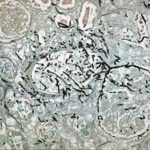
-
High power view (H&E) of uniform septate hyphae which show typical diclotomous branding characteristic of Aspergillus taken from mitral valve vegetation in a patient with disseminated aspergillosis. The hyphae are present within a background of fibrinous material.
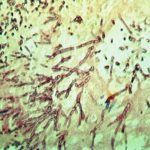
-
Medium power view (H&E) of lung tissue in patient with invasive pulmonary aspergillosis in which many of the fungal hyphae are seen in cross section.
